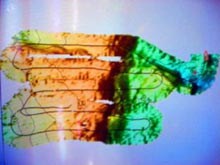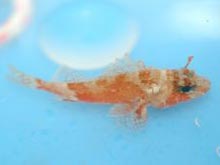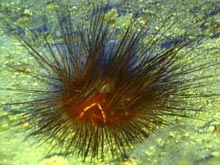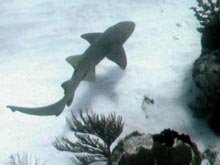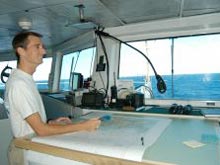
NOAA Corps Lieutenant Junior Grade Shawn Maddock stands watch on the bridge of the Ronald H. Brown.
A Detour and a Dive on Diaphus Bank
September 29, 2003
Catalina Martinez
NOAA Office of Ocean Exploration
Sarah Bernhardt
Flower Garden Banks National Marine Sanctuary, NOAA
The watch stander on any large vessel has a great deal of responsibility, and one of his or her many important tasks is to record sea conditions and weather each hour. According to the bridge log on the NOAA Ship Ronald H. Brown, the seas were consistently between 9 and 10 ft this morning. Since it was too rough to launch the ROV (remotely operated vehicle), the decision was made to continue with the eastern multibeam transect until conditions became more conducive to diving.
Fortunately, the seas settled down to a height of about 6 ft in the late afternoon, and at that point, our location was close to a shelf edge bank/feature called Diaphus Bank, named after the retired Texas A&M University submersible that did the original surveys of this part of the Gulf of Mexico. The Flower Garden Banks National Marine Sanctuary research team had been interested in Diaphus Bank for some time, but due to its location more than 169 nautical mi east of the sanctuary boundaries, it was not considered in the initial cruise plan. The true nature of exploration was demonstrated as the science team altered plans once again and decided to dive on Diaphus instead of risking transit time, since there was no telling how large this window of opportunity would be.
After about five hrs of surveying and sampling at four locations at Diaphus Bank, the ROV managed to travel just 1,500 m from the original starting location on the bottom. The dive at Diaphus was too deep for algae (about 100 m), but there was great diversity of corals, invertebrates, and fishes at this depth. Some of the most exciting collections of the dive included a small red scorpionfish and a poisonous sea anemone. Scorpionfish have poisonous barbs extending from their scales, making them very dangerous to handle. These poisonous barbs also assist in protecting the fish from predation. The beautiful berried sea anemone (Alicia mirabilis) is probably the most toxic anemone in the Western Hemisphere. Its beauty is deceiving, and this flowerlike organism must be handled with extreme caution.
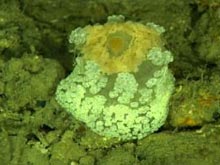
The rare and highly poisonous berried anemone (Alicia mirabilis) is the only anemone in the Caribbean-Atlantic region with a sting that is toxic to all animals. The body of the berried anemone can be contracted as shown here, or can extend for more than 12 inches over the sea floor. Click image for larger view.
Several other interesting finds from the treasure trove of samples included a beautiful sea urchin (Astropyga magnifica) with a mysterious stowaway tucked between its long spines. The stowaway, a tiny commensal shrimp (Tuleariocaris neglecta), was previously associated only with the long-spined Diadema sp. urchins. This is the first record of this shrimp using this sea urchin as a host.
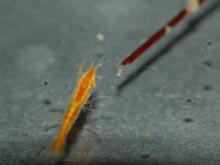
This tiny shrimp (Tuleariocaris neglecta) is reported to live amongst the spines of the long-spined urchin (Diadema sp.), but this individual was collected with the beautiful Astropyga magnifica urchin at Diaphus Bank. This is the first time this species of shrimp has been recorded in cohabitation with this species of sea urchin. The shrimp is photographed here next to a single spine of the urchin. Click image for larger view.
Another surprising discovery among the samples collected at Diaphus Bank was a small, brightly colored squat lobster with amusing eyes, collected incidentally with a sponge.
The seas began to build again near the end of the dive, and recovery of the ROV was rather difficult in the high winds. Thus, the decision was made to move closer to shore to attempt a deeper dive in a region located within the Mississippi Canyon, in the hope that the weather would improve during transit. All are optimistic that the weather will hold, but are also ready for contingency planning in the event of heavy seas.

A great barracuda (Sphyraena barracuda) swims through coral reef habitat on the west coast of Mona Island, Puerto Rico. Barracudas, as piscivorous (fish eaters) and general carnivores, are one of the top predators of the reef ecosystem. They use bursts of speed and sharp teeth to catch their prey. They are found frequently over coral reefs, near mangroves, and in seagrass beds. Click image for larger view.
Dinner on the Reef: A Clue to Ecology
Ron Hill, PhD
Research Fisheries Biologist
NOAA Fisheries, Southeast Fisheries Science Center-Galveston
A coral reef ecosystem is an exciting place. Ask a diver and he will tell you there are exciting things to look at. A fisherman will tell you there are exciting fish to catch. A school child from the heartland of America may tell you that coral reefs make exciting subjects on the Discovery Channel®, and a coral reef ecologist, this one, for example, might tell you there are exciting interactions going on below the surface.
Interactions, obvious and subtle, are what ecology is all about. Ecologists strive to understand how organisms affect their environments and how their environments affect them. Ecology is especially fascinating (and complicated) in coral reef ecosystems, where thousands of species of coral, fish, algae, sponges, and other organisms depend on numerous integrated habitats for their existence.
Coral reef ecology takes on a new perspective when you compare coral reefs from the Caribbean Sea, where reefs are common, with the coral reefs protected within the Flower Garden Banks National Marine Sanctuary in the northern Gulf of Mexico, where coral reefs are rare. The Flower Garden Banks are at the geographic limit of many of the corals and associated organisms that make up these unique communities. Further north, water temperatures are too cold for reef-building corals to thrive and survive. Studying organisms near their environmental extremes tells us a lot about how organisms live and how ecosystems function in “normal” conditions.
One way to understand how ecosystems function is to look at demographics -- population characteristics such as where fish (or plants) live, how they behave, when and how they reproduce, what they eat, and who eats them. In large part, trophic relationships -- who eats whom -- tell you a lot about other demographic characteristics. For example, if you find that a barracuda has eaten an octopus, it tells you that they occur in the same locations or habitat, at least during feeding time for the barracuda. If you find that nurse sharks on the reef frequently eat pink shrimp but never eat brown shrimp, you can bet it is not because they taste different, but because the shrimp occur in different habitats -- nurse sharks just aren’t that picky about what they eat. So a study of food habitats can help us infer a lot about other aspects of ecology, as well.
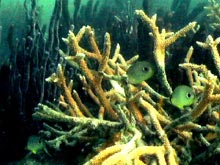
Foureye butterflyfish (Chaetodon capistratus) snack on a colony of staghorn coral (Acropora cervicornis) off La Parguera, Puerto Rico. Some butterflyfish feed primarily on corals by carefully picking individual polyps off the colony. The presence of butterflyfishs has been proposed as a means to assess the health of a coral reef system; in this role, they are known as an indicator species. Click image for larger view.
We are studying feeding and trophic relationships by creating mathematical models of our ecosystem, the goal being to map out relationships like a network or a flow diagram. We are using software called Ecopath with Ecosim (available at www.ecopath.org ![]() ). The software is easy to use and incorporates the mathematical equations necessary to create dynamic trophic models. The researcher inputs diet composition, density (e.g., number of organisms per square meter), and consumption rates (how much the animal eats in a given period of time). From this basic information, Ecopath creates a model that shows how energy, represented by food, flows through the ecosystem from the simple planktonic organisms up to the largest whales and sharks.
). The software is easy to use and incorporates the mathematical equations necessary to create dynamic trophic models. The researcher inputs diet composition, density (e.g., number of organisms per square meter), and consumption rates (how much the animal eats in a given period of time). From this basic information, Ecopath creates a model that shows how energy, represented by food, flows through the ecosystem from the simple planktonic organisms up to the largest whales and sharks.
In coral reef ecosystems (and in our coral reef model) phytoplankton, algae, other plants, and corals form the basis of the food web through photosynthesis (primary producers). Corals are hybrids where energy is concerned. Their tissues contain symbiotic algae that make food that is shared with the corals, but the corals also capture food from the water column.
Primary consumers, such as herbivorous surgeonfish, sea urchins and planktivorous damselfish, feed directly on the primary producers. Some of these relationships are fascinating. Some damselfish maintain small "lawns" of algae to supply their own needs, chasing away much larger competitors with their aggressive displays. Corals have specialized predators, such as butterflyfish, that “pick coral polyps” when feeding.
Secondary consumers, such as grunts, small groupers and triggerfish, feed on the primary consumers. And top predators, such as sharks and large jacks, feed on all the lower trophic levels. In between these generalized classifications are innumerable variations in the trophic habits of most species, and a lot of overlap in what different groups eat. In truth, food is found everywhere you look on the reef, and some fish or lobster or snail or other organism has evolved to take advantage of it. In our models, we are interested in studying fishing and its effects, so people (fishermen) are classified as top predators; people catch species from every trophic level in the sea.
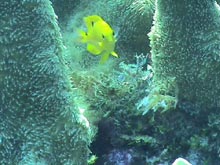
A juvenile threespot damselfish in a pillar coral (Dendrogyra cylindrus) in Mona Island, Puerto Rico. Threespot damselfish are highly territorial, protecting the resources within their domain. They will aggressively attack and posture to scare off competitors, regardless of their size. Click image for larger view.

This diagram shows the flow of energy, as food, through an idealized coral reef model as produced by Ecopath with Ecosim software. Arrows show the flux of food from prey to predator. Other information is available for an actual model, but this one has been simplified to clearly show the connections between trophic groups. Benthic producers include algae, seagrasses and zooxanthellae. Sessile animals include corals, octocorals, and sponges. Click image for larger view.
Although the model construction procedure is somewhat simple, it is the scientist’s job to determine whether or not the finished model accurately represents the system. If not, more research may be needed. Models are an excellent way to assess the data that are available to help us understand various ecosystems. For our study of trophic dynamics on Atlantic coral reefs, we are building models of the Flower Garden Banks and a Caribbean reef platform in Puerto Rico. Both reef systems have been studied for many years, so a lot of data are available. Explorations such as ours aboard the NOAA Ship Ronald H. Brown ![]() allow us to gather additional information on the abundance and density of fish, algae, corals, sponges, crustaceans, and many other organisms.
allow us to gather additional information on the abundance and density of fish, algae, corals, sponges, crustaceans, and many other organisms.






















